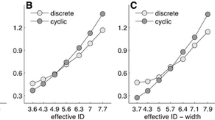Abstract
The linear relationship between movement time (MT) and index of difficulty (ID) for Fitts’ type tasks has proven ubiquitous over the last 50+ years. A reciprocal aiming task (IDs 3, 4.5, 6) was used to determine if an enlarged visual display (visual angle 5.1°, 7.4°, or 13.3°) would alter this relationship. With ID = 6, a condition typically associated with discrete action control, the largest visual display (13.3°) allowed the motor system to exploit features of cyclical action control, e.g., shorter dwell times, more harmonic motion, less time decelerating the limb. The large visual display resulted in a quadratic relationship between MT and ID. For the IDs of 3 and 4.5, the visual displays did not alter the underlying control processes. The results are discussed in terms of the preference of the motor system to assemble movements from harmonic basis functions when salient visual information is provided.

Similar content being viewed by others
References
Adam JJ, Paas FGWC (1996) Dwell time in reciprocal aiming tasks. Hum Mov Sci 15:1–24
Adam JJ, van der Bruggen DPW, Bekkering H (1993) The control of discrete and reciprocal target-aiming responses: evidence for the exploitation of mechanics. Hum Mov Sci 12:353–364
Adam JJ, Mol R, Pratt J, Fischer MH (2006) Moving further but faster: an exception to Fitts’s law. Pscyhol Sci 17:794–798
Buchanan JJ, Park JH, Ryu YU, Shea CH (2003) Discrete and cyclical units of action in a mixed target pair aiming task. Exp Brain Res 150:473–489
Buchanan JJ, Park JH, Shea CH (2004) Systematic scaling of target width: dynamics, planning, and feedback. Neurosci Lett 367:317–322
Buchanan JJ, Park JH, Shea CH (2006) Target width scaling in a repetitive aiming task: switching between cyclical and discrete units of action. Exp Brain Res 175(4):710–725
Crossman ERFW, Goodeve PJ (1983) Feedback control of hand-movement and Fitts’ law. Q J Exp Psychol 35A:251–278
Fitts PM (1954) The information capacity of the human motor system in controlling the amplitude of movement. J Exp Psychol 47:381–391
Fitts PM, Peterson JR (1964) Information capacity of discrete motor responses. J Exp Psychol 67:103–112
Langolf GD, Chaffin DB, Foulke, JA. (1976). An investigation of Fitts’ law using a wide range of movement amplitudes. J Mot Behav 8:113–128
Guiard Y (1993) On Fitts’s and Hooke’s laws: simple harmonic movement in upper-limb cyclical aiming. Acta Psychol 82:139–159
Guiard Y (1997) Fitts’ law in the discrete vs cyclical paradigm. Hum Mov Sci 16:97–131
Jirsa VK, Kelso JAS (2004) The excitator as a minimal model for the coordination dynamics of discrete and rhythmic movement generation. J Mot Behav 37:35–51
Kelso JAS (1992) Theoretical concepts and strategies for understanding perceptual-motor skill: from information capacity in closed systems to self-organization in open, nonequilibrium systems. J Exp Psychol Gen 121:260–262
Mechsner F, Kerzel D, Knobllch G, Prinz W (2001) Perceptual basis of bimanual coordination. Nature 414:69–73
Meyer DE, Kornblum S, Abrams RA, Wright CE, Smith JEK (1988) Optimality in human motor performance: Ideal control of rapid aimed movements. Psychol Rev 95:340–370
Mottet D, Bootsma RJ (1999) The dynamics of goal-directed rhythmical aiming. Biol Cybern 80:235–245
Mourik AM, Beek PJ (2004) Discrete and cyclical movements: unified dynamics or separate control. Acta Psychol 117:121–138
Plamondon R, Alimi AM (1997) Speed/accuracy trade-offs in target-directed movements. Behav Brain Sci 20:279–349
Schöner G (1990) A dynamic theory of coordination of discrete movement. Biol Cybern 63:257–270
Smits-Engelsman BCM, Swinnen SP, Duysens J (2006) The advantage of cyclical over discrete movements remains evident following changes in load and amplitude. Neurosci Lett 396:28–32
Author information
Authors and Affiliations
Corresponding author
Rights and permissions
About this article
Cite this article
Kovacs, A.J., Buchanan, J.J. & Shea, C.H. Perceptual influences on Fitts’ law. Exp Brain Res 190, 99–103 (2008). https://doi.org/10.1007/s00221-008-1497-3
Received:
Accepted:
Published:
Issue Date:
DOI: https://doi.org/10.1007/s00221-008-1497-3




